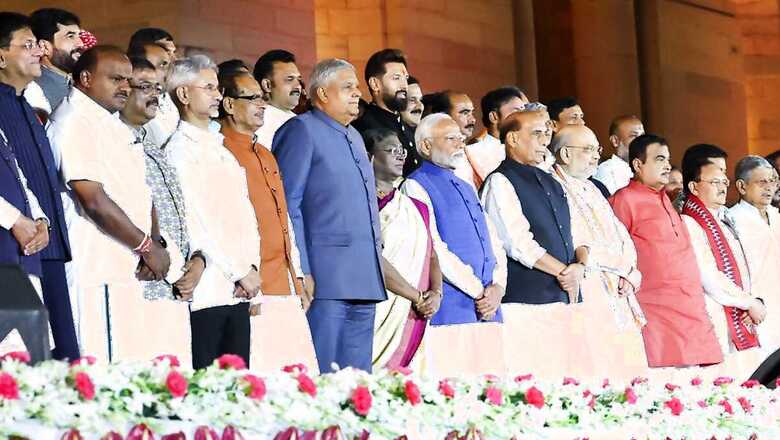
views
On June 10, the first full working day of his third term, Prime Minister Narendra Modi had an action-filled day. He attended office in the South Block in the morning, chaired the first meeting of his Cabinet in the evening, and in between, exchanged pleasantries with the prime ministers of Pakistan and Canada.
Day one of the third consecutive term of Prime Minister Modi was marked with three salutary decisions-
- The release of the 17th installment of the Kisan Nidhi Scheme. The prime minister’s first official action on Monday was to sign off on the release of the Rs 20,000 crore instalment, benefiting an estimated 9.3 crore farmers.
- The first decision taken during the inaugural Cabinet meeting held in the evening was to allocate an additional three crore rural and urban housing units under the Pradhan Mantri Awas Yojana (PMAY), scheduled to be completed over the next five years. This ambitious plan would require an investment of approximately Rs 5,00,000 crore. Notably, these PMAY houses will be equipped with essential amenities such as toilets, electricity, and cooking gas connections, ensuring dignified living conditions for their occupants.
- The highly anticipated decision awaited by the nation, along with opinion makers, particularly in light of alleged arm-twisting by coalition partners, was the last to be announced on that day: portfolio allocation. It was expected to be a tightrope walk for the prime minister. However, the way it unfolded, I call it a mission impossible not only made possible but made to look simple.
Significant messages are emerging from the allocation of portfolios. The more important are as under-
One, Prime Minister Modi, as in his previous administrations, has retained control of the Ministry of Personnel, Public Grievances and Pensions; the Department of Atomic Energy; the Department of Space; all significant policy issues; and any portfolios not specifically allocated to other ministers.
Two, PM Modi has once again shown complete faith in his trusted inner circle. The Cabinet’s fulcrum remains not only intact but further fortified, with its heavyweights entrusted to shoulder the weightiest responsibilities. The portfolio allocation reflects continuity from the prime minister’s previous two terms, demonstrating a judicious distribution of ministries. Notably, incoming heavyweights, particularly experienced former chief ministers, have been entrusted with key roles, regardless of their party affiliations. Even the allotment of the portfolios to junior ministers exhibits careful consideration and strategic thinking.
Three, the biggest indication of continuity stems from the fact that there have been no changes in the critical Cabinet Committee on Security (CCS), with Defence Minister Rajnath Singh, Home Minister Amit Shah, Finance Minister Nirmala Sitharaman, and External Affairs Minister S. Jaishankar retaining their respective portfolios. This signifies that the prime minister has complete confidence in his core team, upon whom the most significant governance decisions depend. Amit Shah makes history as the first home minister to secure a second term, while Nirmala Sitharaman becomes the first woman finance minister to achieve this feat. S. Jaishankar also breaks new ground as the first EAM to be reappointed.
Four, Prime Minister Modi has also reaffirmed his confidence in experienced ministers from his previous term, alongside welcoming new heavyweights to the Cabinet.
Several key figures have retained their portfolios: JP Nadda returns to the Ministry of Health, adding the Ministry of Chemicals and Fertilisers to his responsibilities, Nitin Gadkari retains his famous Ministry of Road Transport and Highways, while Piyush Goyal continues to lead the Ministry of Commerce and Industry. Dharmendra Pradhan remains at the helm of the Ministry of Education, while Ashwini Vaishnaw retains Railways, Electronics and Information Technology, and assumes additional responsibility for the Ministry of Information and Broadcasting. Hardeep Singh Puri continues to oversee Petroleum and Gas, and Bhupender Yadav retains his role at the Ministry of Environment, Forest and Climate Change at a time when global warming led climate change is becoming a real threat to the nation.
Five, apart from Prime Minister Modi and Rajnath Singh, there are five former chief ministers in the NDA 3.0 government. The portfolio allocation does complete justice to their experience and expertise.
- Veteran administrator Shivraj Singh Chouhan, widely acclaimed for his stellar performance in leading the BJP in Madhya Pradesh, takes on the crucial Agriculture, Farmers Welfare, and Rural Development portfolio, at a critical juncture of agrarian unrest. This appointment comes at a time when Indian agriculture has primarily become a two-crop phenomenon (rice and paddy) due to high Minimum Support Prices (MSP) and next-generation agrarian reforms are need of the hour.
- Manohar Lal Khattar takes charge of the Housing and Urban Affairs portfolio at a time when the urban landscape is undergoing significant changes and rapid urbanisation is occurring. Cities and towns are increasingly contributing to the country’s GDP, with their share nearing 75 per cent. He also has to shoulder the important Ministry of Power.
- HD Kumaraswamy takes on the weighty responsibility of the Heavy Industries and Steel Ministries. This appointment is significant given that India’s journey to becoming a developed nation hinges on substantial growth in both steel production and consumption. Currently, India’s per capita steel consumption lags significantly at 81 kg, compared to the global average of 219 kg and China’s substantial 646 kg.
- Jitan Ram Manjhi is entrusted with the Ministry of MSME. If the malady of growth without commensurate employment generation, which has been observed in much of independent India, is to be cured, MSMEs must play a pivotal role. Manjhi, along with Piyush Goyal (Commerce and Industry) and HD Kumaraswamy (Heavy Industries), faces the formidable task of boosting both the contribution and employment share of industry in the Indian economy. Currently, industry accounts for 27.6 per cent of India’s GDP while employing a mere 17 per cent of the workforce.
- Former Assam Chief Minister Sarbananda Sonowal takes charge of the Ministry of Ports, Shipping, and Waterways, a portfolio crucial to India’s export-led growth as well as reducing India’s internal logistics costs, as inland waterways are the cheapest source of domestic transport.
Six, among those who have been laterally shifted, Jyotiraditya M. Scindia, who served as Civil Aviation Minister in the previous government, now takes on the portfolio of Communications. He also assumes responsibility for the crucial Ministry of Development of the Northeastern Region, a timely appointment given the yearlong unrest in Manipur and the need for a fresh approach to integrating the Northeast with the national mainstream.
Kiren Rijiju moves to the Parliamentary Affairs Ministry, a critical role given the need for effective floor management in the face of a strong Opposition. Rijiju, a Buddhist, will also oversee Minority Affairs. Annapurna Devi, one of only two women elevated to Cabinet rank, takes charge of the Women and Child Development Ministry.
Seven, among the new entrants are several noteworthy figures. Thirty-six-year-old Kinjarapu Ram Mohan Naidu of the TDP, the youngest minister in NDA 3.0, takes charge of the Civil Aviation Ministry as India experiences booming air traffic growth. Chirag Paswan of the Lok Janshakti Party (LJP) gets the Ministry of Food Processing, a role previously held by his father, with a key focus on reducing hidden unemployment in rural areas. Seasoned politician Rajiv Ranjan Singh, alias Lalan Singh, from the JDU assumes leadership of the Panchayati Raj Ministry.
Eight, among the Ministers of State with Independent Charge, several key appointments stand out. Dr Jitendra Singh takes on Science and Technology and Earth Sciences, in addition to several responsibilities within the Prime Minister’s Office. Jayant Chaudhary assumes leadership of the Ministry of Skill Development and Entrepreneurship, alongside his role as MoS in Education.
Arjun Ram Meghwal has been entrusted with independent charge of Law and Justice, while also serving as MoS of Parliamentary Affairs. Jadhav Prataprao Ganpatrao receives independent charge of Ayush and will also serve as MoS of the Ministry of Health and Family Welfare.
Nine, the Cabinet reflects a careful balance between experience, expertise, and youthful energy, particularly notable with the inclusion of 33 new faces in NDA 3.0. While a comprehensive analysis of the 36 junior ministers of state’s roles and responsibilities is beyond the scope of this discussion, it’s clear that their portfolio allocations have been thoughtfully conceived and crafted. Now, the onus is on the cabinet ministers to effectively delegate responsibilities to their deputies in the best interest of good governance.
The author is Multidisciplinary Thought Leader with Action Bias, India Based International Impact Consultant, and key watcher of changing national scenario. He works as President Advisory Services of Consulting Company BARSYL. Views expressed in the above piece are personal and solely those of the author. They do not necessarily reflect News18’s views.















Comments
0 comment